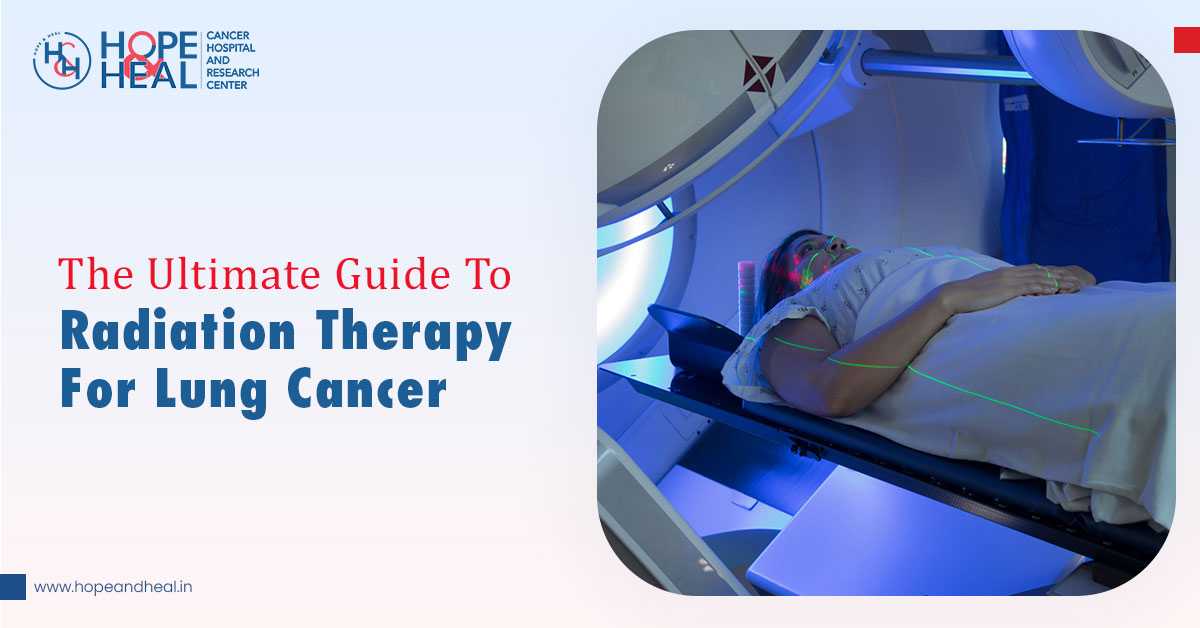Lung cancer occurs when there is an abnormal growth of cells in the lungs. It is one of the leading causes of global cancer deaths. The reason behind lung cancer being deadly is that it gets diagnosed at later stages due to a lack of prominent symptoms in the early stages.
Radiation therapy for lung cancer is a highly popular choice among cancer specialists due to its effectiveness in terms of assisting cure as well as palliative care. However, there is an element of fear involved with lung cancer radiation therapy among people due to the lack of knowledge and insights into its effectiveness.
This blog will act as the ultimate guide to lung cancer radiation therapy.
What are the two types of Lung Cancer?
1.Small Cell Lung Cancer (SCLC): This lung cancer is less common among people, but it can grow rapidly in the lungs. Smoking is considered to be the most prominent factor behind the occurrence of SCLC. The treatment for SCLC is either radiation therapy or chemotherapy.
2.Non-small Cell Lung Cancer (NSCLC): This is the most common type of lung cancer, which can occur in smokers as well as non-smokers. It spreads slowly compared to SCLC. The treatment for NSCLC includes surgery, chemotherapy, or radiation therapy.
Difference Between Chemotherapy and Radiation Therapy in Lung Cancer?
Chemotherapy is given by using drugs and medications that can travel through the bloodstream so that cancer cells that have spread in the body can be killed. It is used for treating cancers that have spread to different parts of the body. On the other hand, radiation therapy or radiotherapy uses high-energy X-rays to kill cancer cells in a specific area, and thus is considered a localised treatment.
How can Radiation Therapy Help You with Lung Cancer?
-
Kills the DNA of cancer cells: High-energy X-rays target the helix structure of cancer DNA, which results in the DNA being damaged. Thus, the targeted and damaged DNA does not allow the cancer cells to grow and spread, which ultimately results in the cancer cells dying. After that, the body flushes away the dead cancer cells with the passage of time.
-
Does not hamper the healthy cells: This aspect holds tremendous significance because healthy cells are essential for the lungs' functioning and repair. The localised targeting of radiation therapy helps in ensuring that the healthy cells do not get damaged or can repair themselves due to minimal intervention, which plays a vital role in promoting healthy lungs.
Types of Radiation Therapy for Lung Cancer
-
External Beam Radiation Therapy: This radiation therapy is given by using high-energy X-rays or beams from a machine that is placed outside the body. However, the high-energy rays are pointed directly at the tumour area, which makes it highly effective. The radiation process is generally painless but requires several sessions, depending on the nature of the lung cancer.
-
Brachytherapy: This radiation therapy is given internally by placing a source emitting high radiation directly near the area of the tumour. The use of a catheter is common while giving Brachytherapy because it helps in reaching the spot of the tumour. In addition, this radiation therapy does not harm the healthy tissues, which makes it an effective option. However, there are two types of Brachytherapy - high-dose radiation therapy and low-dose radiation therapy, which are used based on the stage of lung cancer.
-
Proton Radiation Therapy: This radiation therapy is given by using proton beams for targeting the tumour area specifically, which in turn helps in ensuring that the surrounding healthy tissues or cells do not get damaged. Patients who have reached advanced stages of lung cancer are given proton radiation therapy. If you are worried about radiation therapy hampering your heart and other surrounding organs near the lungs, then treatment based on proton radiation therapy is the safest option because it eliminates or minimises the exposure of other organs to the radiation.
The Advantages of Radiation Therapy for Lung Cancer
-
Effective cure without surgery: Some of the lung cancer patients might have preexisting health complications, such as heart diseases or diabetes, which make it difficult or impossible to perform surgery. Thus, an oncologist suggests treatment based on radiation therapy, which can cure early-stage lung cancer, without the need for surgery. In addition, some lung cancer patients do not choose to go for any kind of surgery, and this is where radiation therapy proves to be beneficial.
-
Assists surgeries: In advanced stages of lung cancer, radiation therapy helps in shrinking or reducing the size of the tumour. This process of shrinking or size reduction helps an oncologist to perform tumour removal surgery without any complications. In the field of clinical surgeries, large tumour sizes make it difficult for surgeons. Therefore, pre-operational radiation therapies prove to be a major game-changer in lung cancer surgeries.
-
Kills cancer cells that have spread to other areas: Sometimes cancer cells from the lungs, especially with SCLC, grow and spread quickly to other parts of the body. This can be a worrying factor because of the ability of cancer cells to multiply and spread quickly. Thus, receiving radiation therapy can help in targeting each of the individual areas where the cancer cells have spread.
-
Assists post-operative treatment: In some cases of lung cancer surgeries, some cancer cells can get left behind. This can prove to be risky because the leftover cells can lead to the recurrence of lung cancer. Thus, radiation therapy can be used post-operation to damage the DNA of the leftover cancer cells. This is a major advantage of this therapy because it stops the potential recurrence of lung cancer.
-
Advanced techniques shorten the number of sessions required: The process of Stereotactic Body Radiation Therapy (SBRT) is proving to be a groundbreaking revolution in terms of reducing the number of sessions that are required for lung cancer treatment. However, this technique is effective for early-stage lung cancer patients.
-
Plays a positive role in palliative care: The pain and discomfort experienced by patients in advanced stages of lung cancer can be tremendous, and this is where palliative care comes into play. The concept of palliative care in lung cancer is based on managing pain and discomfort associated with the disease and treatment. It has been observed that radiation therapy is highly compatible with palliative care for lung cancer patients because it helps in shrinking or reducing the tumour size, which leads to less pain and discomfort. Overall, radiation therapy helps improve the quality of life for lung cancer patients.
What are the Potential Side Effects of Radiation Therapy for Lung Cancer?
-
Fatigue, nausea, and loss of appetite: These are the most common symptoms of side effects involving lung cancer radiation therapy. You might feel tired and weak after radiation therapy sessions, along with suffering from weight loss due to nausea and loss of appetite.
-
Hair loss and skin changes: Radiation Therapy leads to hair loss in the area that received high-energy radiation. In addition, the colour of the skin where radiation was given tends to change or become dry.
-
Difficulty in swallowing: Your oesophagus can be affected due to radiation therapy, which in turn leads to a swallowing problem because it connects the throat to the stomach.
-
Shortness of breath: This is another common side effect of radiation therapy in lung cancer because inflammation of the lung tissue occurs due to this therapy. This symptom may persist for a longer duration because it takes time for the lung tissue to repair.
-
Lung fibrosis: This can occur due to scarring of the lung tissue, which hampers the ability of the lung to function at full power or causes coughs that don’t go away.
Conclusion
It can be concluded by stating that lung cancer has a high mortality rate due to it being diagnosed at advanced stages. It is important for you to refrain from activities or habits that can harm your lungs. Both active and passive smoking are harmful to the lungs. Years of exposure to smoke or harmful chemicals can cause lung cancer. If you are experiencing symptoms such as a persistent cough or shortness of breath regularly, it is advisable to get your lungs tested.
There are several reputed and dedicated cancer specialist hospitals, such as Hope and Heal Cancer Hospital, where you can get your lungs tested with high-level accuracy due to the use of advanced technologies. The key is to trust your oncologist and trust the process of radiation therapy if it is suggested for lung cancer treatment, because of its high-level efficiency in terms of treating lung cancers, especially early-stage lung cancers.
If you or your loved ones are looking for advanced lung cancer treatment, then visit the best cancer hospital near your location now.







